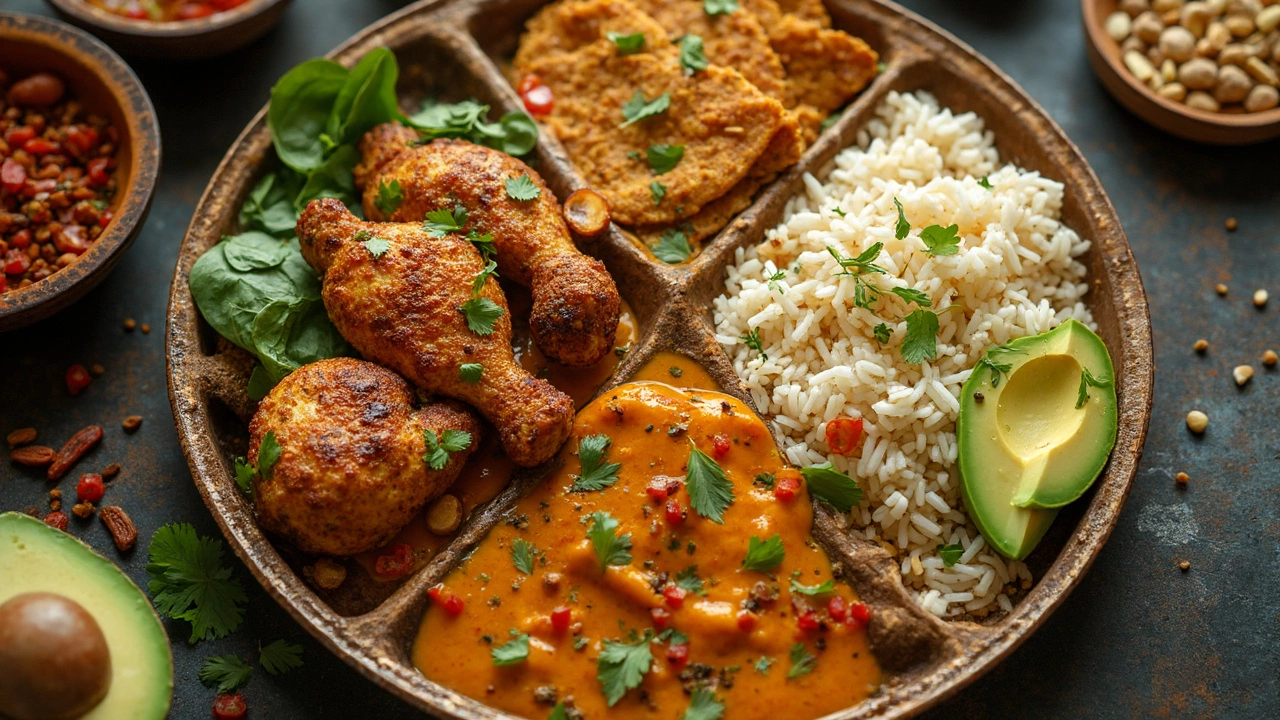Heard people talk about the 40 30 30 rule but never quite sure what it means? It's a simple way to balance what you eat: 40% of your daily calories from carbs, 30% from protein, and 30% from fats. No counting every single bite or skipping favorite meals—the focus is on balance, not total restriction.
This rule got famous because it actually works for a lot of folks, especially those sick of yo-yo dieting. It's the idea behind diets like the Zone Diet. Instead of dropping all carbs or blaming fats, you get a mix that keeps your energy steady and your cravings in check.
Making sense of food labels and portion sizes can be confusing, so here’s a trick: imagine your plate. Fill almost half with colorful veggies and healthy carbs like brown rice or sweet potato, add a palm-sized scoop of chicken or beans, and round it out with a dash of olive oil or a few nuts. That’s the gist, and it doesn’t take a math degree to figure out every meal.
If you’re like me and have a kid always asking why you measure your yogurt or why you swap toast for eggs, the easiest answer is—you’re teaching them balance. Turns out, balance really is the name of the game in this rule.
- Breaking Down the 40 30 30 Rule
- How the 40 30 30 Ratio Affects Your Body
- Practical Tips to Follow the 40 30 30 Rule
- Common Mistakes and How to Avoid Them
Breaking Down the 40 30 30 Rule
The 40 30 30 rule is all about splitting up your calories for the day: 40% from carbs, 30% from protein, and 30% from fat. This isn’t just a random combo. Research from nutrition clinics shows most people feel fuller longer and burn more steady energy when they follow something close to this ratio.
So, what does that look like in normal food? Let’s say your daily calorie goal is 1,800 calories. That means:
- 720 calories from carbs (about 180 grams)
- 540 calories from protein (about 135 grams)
- 540 calories from fat (about 60 grams)
You might be thinking, how do I even figure this out? The easiest way is to use a food-tracking app just for a week or two. But once you get the hang of it, you can eyeball it with simple food swaps and portion logic.
Here’s a basic cheat sheet for what fits in each macro category:
- Carbs: Think whole grains like brown rice, fruit, beans, and veggies.
- Protein: Chicken, fish, eggs, Greek yogurt, tofu, or beans.
- Fats: Olive oil, nuts, seeds, avocado, or fatty fish like salmon.
If you like numbers, check out this calorie breakdown:
| Macronutrient | % of Calories | Calories on 1,800 Cal Diet | Grams per Day |
|---|---|---|---|
| Carbs | 40% | 720 | 180 |
| Protein | 30% | 540 | 135 |
| Fat | 30% | 540 | 60 |
Don’t stress every gram. The goal is getting close, not being perfect. If you’re hitting near these numbers most days, you’re working the plan. The big plus? If you follow the 40 30 30 rule for weight loss, you usually won’t feel as hungry during the day because protein and healthy fats actually keep you full. No more random hangry attacks mid-afternoon.
How the 40 30 30 Ratio Affects Your Body
Splitting your calories into 40% carbs, 30% protein, and 30% fat does more than just change what's on your plate—it can seriously mess with your hunger, energy, and how your body burns fat. Here’s why this mix works for so many people and why weight loss clinics often talk it up:
The 40% carbs part keeps your energy steady. Instead of crazy spikes and crashes, you get a slow burn, which means fewer “hangry” moments. Think of carbs as fuel, but the slower they process, the longer your energy lasts. Whole grains, veggies, and fruit fall into this category and help you skip the dreaded 3 p.m. slump.
Now, for the 30% protein. This is kind of a game-changer. Protein takes longer to digest, so you feel fuller for longer and it helps protect your muscles while losing fat. According to a study in the American Journal of Clinical Nutrition, higher protein diets can help keep cravings down and make you less likely to raid the fridge late at night.
Then there’s 30% healthy fat. Fat got a bad rap in the past, but you actually need it to absorb vitamins, support your hormones, and keep your brain sharp. Healthy fats—like those in salmon, nuts, and olive oil—help control hunger even more. Plus, fat gives flavor, so food actually tastes good when you follow the 40 30 30 rule.
- Steady blood sugar: This ratio is known to help you avoid crashes and wild sugar swings, lowering the risk of mood swings and even diabetes when carried out long term.
- Better fat-burning: Eating more protein and healthy fats pushes your body to burn stored fat, not muscle. Your metabolism gets a little boost, too.
- Muscle support: Combined with exercise, the extra protein helps build and keep muscle, which burns more calories even when you're just sitting around.
| Macronutrient | Role in the Body | Example Foods |
|---|---|---|
| Carbohydrates (40%) | Main energy source, powers workouts | Brown rice, sweet potatoes, fruit |
| Protein (30%) | Builds muscle, keeps you full | Chicken, Greek yogurt, legumes |
| Fat (30%) | Supports hormones, helps absorb vitamins | Avocado, olive oil, nuts |
If you ever feel stuck in a cycle of low-calorie diets and low energy, this balance is worth a shot. It’s not about eating less—it's about eating smarter.

Practical Tips to Follow the 40 30 30 Rule
Sticking to the 40 30 30 rule isn’t as complicated as it might sound. The real deal is just getting into a new groove. You don’t need some fancy software—just a few smart habits.
First, learn which foods fall into each macronutrient group. Carbs aren’t just bread and pasta; think berries, quinoa, and beans too. Protein can be chicken, eggs, Greek yogurt, or even tofu. For healthy fats, grab things like avocado, olive oil, seeds, or nuts.
- Start with Your Plate: Imagine your plate split up. Fill up about 40% with carbs (veggies, fruit, or whole grains), 30% with protein (lean meat, fish, eggs), and the last 30% with healthy fats (a bit of cheese, oils, or nuts). If you eyeball portions, you’re less likely to stress than with calorie counting.
- Track Your Meals: Want to get it right? Track what you eat for a week using a simple food app or old-school journal. See where you’re landing with each meal. You don’t need to track forever; you’ll pick up on patterns pretty quick.
- Keep Snacks Balanced: Snack time can crash your ratios. Pack up a handful of almonds (fat and a bit of protein), and mix in apple slices (carbs). Balanced snacks help keep you full and stop the 3 pm energy dip.
- Don’t Fear Prep: Spend a Sunday night chopping up veggies or grilling chicken. When your fridge is stocked with ready-to-go foods, it’s way easier to stick with the 40 30 30 rule and not panic order pizza.
- Read Labels: Most packaged foods have nutrition info. Flip over the package and check the grams of protein, carbs, and fats. As a rule of thumb, if a snack is packed with sugar and zero protein, it probably throws off the balance.
Here’s a quick glance at rough macronutrient goals if you’re eating around 1,800 calories per day, just for reference:
| Nutrient | Daily Grams |
|---|---|
| Carbohydrates (40%) | 180g |
| Protein (30%) | 135g |
| Fat (30%) | 60g |
If your daily calories are different, plug your number into an online macro calculator to get your exact goals.
Don’t get overwhelmed. Most people trip up by overthinking it. Keep meals mostly whole foods, balance those three 40 30 30 categories, and you’re on the right track. Once you get the hang of it, hitting the 40 30 30 rule becomes just another part of your regular day.
Common Mistakes and How to Avoid Them
Most people using the 40 30 30 rule trip up on the details. The numbers sound simple, but habits can throw you off. Here are the biggest mistakes people make and easy ways you can dodge them.
- Misjudging Portions: It's easy to underestimate or overestimate your servings, especially when eating out or cooking without measuring. A lot of foods look smaller (or bigger!) than their actual calorie count. Try using a food scale for the first few weeks or check nutrition labels more often, so you nail down what a real "serving" is.
- Choosing the Wrong Carbs: All carbs aren't equal. Grabbing a donut instead of brown rice doesn't just mess with your energy—it also spikes your insulin and leaves you more likely to snack later. Stick to whole grains, beans, fruit, and veggies for the 40% carbs part of your plan.
- Not Enough Protein Variety: Falling into a rut with protein happens fast. If you eat nothing but chicken breast or protein bars, you'll get bored—and your body won't get everything it needs. Mix it up: eggs, fish, tofu, Greek yogurt, lentils, and lean beef all work for that 30% protein spot.
- Ignoring Good Fats: People hear "fat" and still picture greasy fast food. But 30% healthy fats is about nuts, seeds, olive oil, and avocado—not drive-thru fries. Add them sparingly, since fat packs a calorie punch, but don't skip them entirely.
- Forgetting Liquid Calories: Coffee creamers, soda, fancy teas, and those after-work craft beers slide into your diet and throw off your macros. There’s nothing wrong with a treat, but account for the calories and macros in drinks too.
- Getting Obsessed With Math: Some folks get tangled in tracking apps and spreadsheets, making the plan way harder than it needs to be. A rough estimate and some practice is all it takes. Focus more on quality foods with good balance than chasing exact percentages at every meal.
Here’s a snapshot to make the 40 30 30 rule easier in daily life:
| Food Type | Common Errors | Smart Fixes |
|---|---|---|
| Carbs | Relying on white bread, sweets | Switch to whole grains, fruits, veggies |
| Protein | Too much processed meat | Mix animal and plant sources |
| Fats | Skipping healthy oils | Use nuts, seeds, olive oil |
| Portions | Guessing, oversized plates | Use your hand or a food scale |
When I was first trying this, I fell into the same traps—especially eating too many “healthy” granola bars thinking they fit the macros. Turns out, most are packed with sugar. Little habits make a big difference. If you slip up, just reset the next meal—no need to throw out the whole day.
